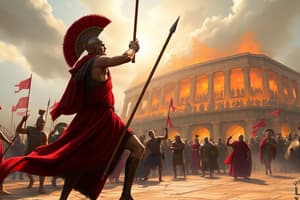Podcast
Questions and Answers
When was the Battle of Thermopylae?
When was the Battle of Thermopylae?
August 480 BC
Where was the Battle of Thermopylae?
Where was the Battle of Thermopylae?
The Pass of Thermopylae, on the Malian Gulf in Mainland Greece
Who fought on the Greek side?
Who fought on the Greek side?
A resistance force made up of soldiers from around 30 allied Greek city-states, approximately 7000 soldiers, led by the Spartan King Leonidas and 300 Spartan warriors.
Who fought on the invading side?
Who fought on the invading side?
What was the Ionian Revolt?
What was the Ionian Revolt?
Why was the Ionian Revolt significant?
Why was the Ionian Revolt significant?
Why did the First Greco-Persian War occur?
Why did the First Greco-Persian War occur?
What happened at the First Greco-Persian War?
What happened at the First Greco-Persian War?
What was the reason for Xerxes' attack on Greece?
What was the reason for Xerxes' attack on Greece?
How did many Greek states feel about the invasion?
How did many Greek states feel about the invasion?
How and why was the Greek side of the Battle of Thermopylae brought about?
How and why was the Greek side of the Battle of Thermopylae brought about?
Why did the Greeks want to delay the Persian advance?
Why did the Greeks want to delay the Persian advance?
Aside from delaying Xerxes' invasion, what other factor motivated the soldiers at Thermopylae to fight?
Aside from delaying Xerxes' invasion, what other factor motivated the soldiers at Thermopylae to fight?
What was the Persian Army like?
What was the Persian Army like?
What was the difference in weaponry between the hoplites and the Persians?
What was the difference in weaponry between the hoplites and the Persians?
Where did the Greek forces begin at the battle?
Where did the Greek forces begin at the battle?
What happened when the Persians arrived?
What happened when the Persians arrived?
Flashcards are hidden until you start studying
Study Notes
Battle Overview
- The Battle of Thermopylae took place in August 480 BC.
- It occurred at the Pass of Thermopylae, located on the Malian Gulf in mainland Greece.
Greek Forces
- A coalition of approximately 7,000 soldiers from around 30 allied Greek city-states participated.
- The Greek forces were led by Spartan King Leonidas, accompanied by 300 elite Spartan warriors.
Persian Forces
- The Persian army, led by King Xerxes, consisted of an estimated 70,000 to 300,000 men.
Background: Ionian Revolt
- The Ionian Revolt began in 499 BC when Greek states in Ionia rebelled against Persian rule.
- Although the revolt was ultimately suppressed, it marked the first significant conflict between Greece and Persia.
First Greco-Persian War
- King Darius of Persia initiated the First Greco-Persian War as revenge against Athens for supporting the Ionian Revolt.
- The war lasted from 492-490 BC, concluding with a significant Greek victory at the Battle of Marathon.
Xerxes’ Motivation
- After Darius's death, Xerxes sought to conquer Greece, aiming for stability in his empire without enslaving Greeks or destroying their culture.
- Many Greek city-states were apprehensive towards the invasion, preferring to side with the Persians rather than face destruction.
Greek Strategy at Thermopylae
- The battle was a strategic decision by a coalition of Greek states to delay the Persian advance.
- The Greeks aimed to disrupt Xerxes' supply lines, relying on the winter storms that made naval supply lines vulnerable.
Delaying Tactics
- Greek forces intended to buy time for evacuating cities like Athens to protect civilian lives from the advancing Persian army.
Composition of the Persian Army
- Xerxes’ army was a multi-cultural force, consisting of soldiers from Persia, Medes, and various subject nations with diverse languages, cultures, and training.
Greek Weaponry Advantages
- Greek hoplites wielded bronze-covered shields (hoplon) and long spears, giving them an edge over the lighter-armed Persian soldiers.
- Persian troops were not accustomed to facing heavily armored opponents, which gave the Greeks a tactical advantage in close combat.
Initial Engagement
- Greek forces established a defensive position by building a wall across the Pass of Thermopylae.
- The four-day standoff surprised Xerxes, as the Greeks maintained their composure and did not flee, showcasing their determination.
Greek Resolve
- Despite expecting the Greeks to capitulate under pressure, their discipline and resilience were evident, with Spartans engaging in routines like exercising and grooming during the standoff.
Studying That Suits You
Use AI to generate personalized quizzes and flashcards to suit your learning preferences.




